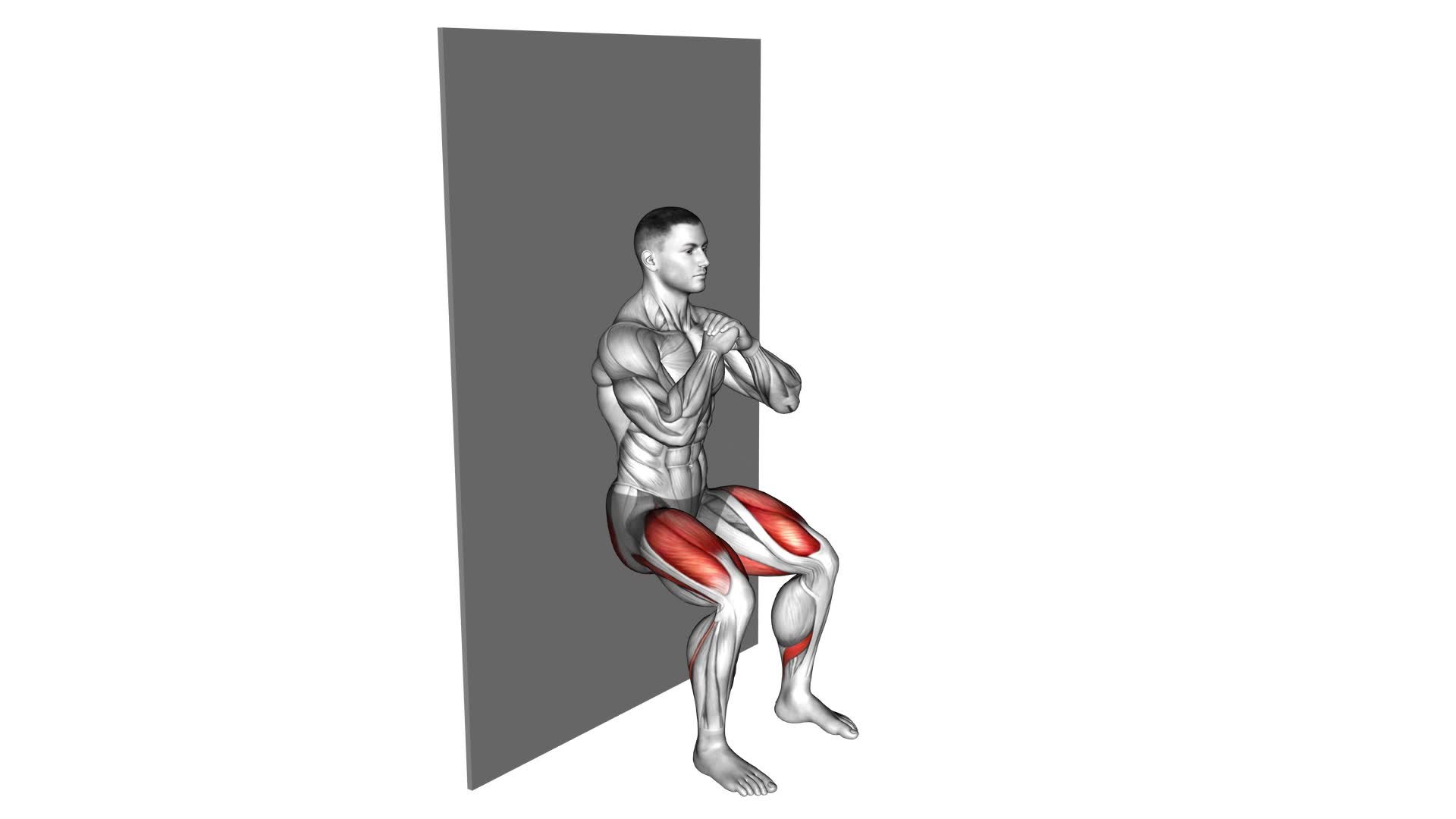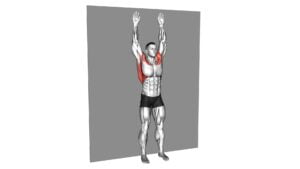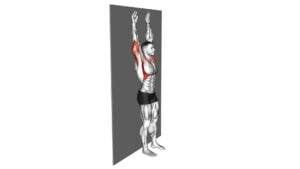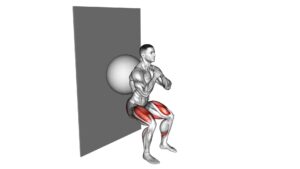Bodyweight Wall Squat – Video Exercise Guide & Tips

Are you looking for an effective lower body exercise that you can do anywhere? Look no further than the bodyweight wall squat!
Watch This Exercise Video
In this video exercise guide, we'll show you the proper form and technique, as well as modifications for different fitness levels.
Avoid common mistakes and maximize the effectiveness of this exercise with our expert tips.
Get ready to tone and strengthen your legs with the bodyweight wall squat!
Key Takeaways
- Improved strength in leg muscles (quadriceps, hamstrings, glutes)
- Enhanced performance in other exercises and activities (running, jumping, climbing stairs)
- Increased stability and core activation
- Improved overall posture and spine health
Benefits of Bodyweight Wall Squats
You will experience numerous benefits by incorporating bodyweight wall squats into your workout routine. One of the main benefits is the improvement in strength. As you lower yourself into the squat position and push against the wall, your leg muscles, including your quadriceps, hamstrings, and glutes, are engaged and strengthened. This increased strength can translate to improved performance in other exercises and activities, such as running, jumping, or climbing stairs.
Another benefit of bodyweight wall squats is the improvement in stability. As you hold the squat position against the wall, your core muscles are activated to maintain your balance. This helps to strengthen your core and improve overall stability, which is crucial for maintaining proper form in other exercises and preventing injuries.
Additionally, bodyweight wall squats can help improve your posture. By engaging your back and shoulder muscles to maintain an upright position against the wall, you're training your body to maintain good posture throughout the day. This can have long-term benefits for your spine health and overall posture.
Proper Form and Technique
To perform bodyweight wall squats with proper form and technique, it's important to focus on maintaining a straight back and a controlled descent. Many people have misconceptions about proper squat form, thinking that bending the knees too far forward or allowing the knees to collapse inward is the correct way to perform a squat. However, this can put unnecessary strain on the knees and increase the risk of injury. Instead, you should focus on sitting back with your hips and keeping your knees in line with your toes throughout the movement.
Engaging your core muscles during wall squats is crucial for maintaining proper form and stability. Your core acts as a stabilizer and helps to support your spine during the exercise. By activating your core, you can prevent excessive forward lean and maintain an upright posture throughout the movement. To engage your core, imagine pulling your belly button towards your spine and bracing your abs. This will help to stabilize your torso and prevent any excessive movement.
Modifications for Different Fitness Levels
For individuals at different fitness levels, there are various modifications available for the bodyweight wall squat exercise. Whether you're a beginner looking to build strength or an advanced athlete looking to challenge yourself, these adaptations and progressions can help tailor the exercise to your specific needs.
Here are four modifications to consider:
- Shallow Squat: If you're new to the exercise or have limited mobility, start by performing a shallow squat. This means bending your knees slightly and keeping the range of motion smaller. As you get more comfortable, gradually increase the depth of your squat.
- Assisted Squat: For those who struggle with balance or have weak leg muscles, using a stability ball or resistance band can provide assistance. Place the ball against the wall and lean your back into it as you squat. Alternatively, loop a resistance band around your thighs to provide extra support.
- Single-Leg Squat: Once you have mastered the basic wall squat, challenge yourself by performing a single-leg squat. Stand about a foot away from the wall, extend one leg forward, and slowly lower yourself down into a squat using the other leg. This variation targets your glutes, quads, and hamstrings more intensely.
- Weighted Squat: For advanced individuals looking to increase the intensity of the exercise, incorporating weights can be beneficial. Hold a dumbbell or kettlebell against your chest as you squat, making sure to maintain proper form and control throughout the movement.
Common Mistakes to Avoid
What are some common mistakes to avoid when performing the bodyweight wall squat exercise?
Proper technique is crucial to get the most out of this exercise and avoid potential injuries. One common mistake is allowing your knees to extend beyond your toes. This puts excessive strain on your knees and can lead to discomfort or injury. To prevent this, make sure to keep your knees directly above your ankles throughout the movement.
Another mistake is rounding your back or leaning too far forward. This puts unnecessary pressure on your lower back and decreases the effectiveness of the exercise. Instead, maintain a straight back and engage your core muscles to support your posture.
Additionally, not going low enough can limit the benefits of the wall squat. Aim to lower yourself until your thighs are parallel to the ground, ensuring a full range of motion.
Finally, avoid using momentum to push yourself up. Instead, focus on engaging your leg muscles to drive yourself back to the starting position.
Tips for Maximizing the Effectiveness
To maximize the effectiveness of the bodyweight wall squat exercise, try incorporating these tips into your routine:
- Maintain proper form: Keep your feet shoulder-width apart and your back flat against the wall throughout the exercise. This will ensure that you're engaging the correct muscles and maximizing results.
- Control your descent: Slowly lower yourself down into the squat position, focusing on the muscles in your legs and glutes. This controlled movement will increase the intensity of the exercise and help you build strength.
- Add variations: Once you have mastered the basic bodyweight wall squat, you can increase the difficulty by incorporating variations. Try using one leg at a time or holding weights to challenge your muscles even more.
- Progress gradually: As with any exercise, it's important to gradually increase the difficulty over time. Start with a comfortable number of repetitions and gradually add more as you get stronger. This progressive overload will ensure that you continue to see improvements in strength and muscle tone.
Frequently Asked Questions
Can Bodyweight Wall Squats Help With Improving Posture?
Bodyweight wall squats can definitely help improve your posture. By engaging your core, glutes, and leg muscles, they promote overall strength and stability in your body.
To properly perform a bodyweight wall squat, stand with your back against a wall, feet shoulder-width apart, and slowly lower yourself into a seated position, keeping your knees aligned with your toes. Hold for a few seconds, then push through your heels to return to the starting position.
Repeat for maximum effectiveness.
What Is the Recommended Number of Repetitions and Sets for Bodyweight Wall Squats?
To improve your posture, you might consider doing bodyweight wall squats. These exercises can be beneficial for strengthening your lower body muscles and promoting proper alignment.
When it comes to the recommended number of repetitions and sets for bodyweight wall squats, it's important to start with a manageable amount and gradually increase as you become more comfortable.
It's always best to consult with a fitness professional to determine the right dosage for your specific needs and goals.
Are Bodyweight Wall Squats Suitable for Individuals With Knee or Back Pain?
Before attempting bodyweight wall squats, individuals with knee or back pain should consult a doctor.
It's important to prioritize your safety and well-being, especially when dealing with any existing health issues.
If you have knee or back pain, modifications can be made to make the exercise more suitable for you.
However, it's still crucial to seek professional advice to ensure that you're performing the exercise correctly and without causing further harm.
Can Bodyweight Wall Squats Help in Building Muscle Mass?
Bodyweight wall squats can indeed help in building muscle mass. While weighted squats are known for their effectiveness in muscle growth, bodyweight exercises like wall squats also have their benefits.
By performing bodyweight wall squats, you engage multiple muscle groups, including your quadriceps, hamstrings, and glutes. This can lead to increased muscle strength and size over time.
Additionally, bodyweight exercises are convenient and can be done anywhere without the need for equipment, making them a great addition to your muscle-building routine.
What Are Some Alternative Exercises That Can Be Done Alongside Bodyweight Wall Squats for a Complete Lower Body Workout?
Looking for alternative exercises to complement your bodyweight wall squats?
There are plenty of options to achieve a complete lower body workout.
Try lunges, step-ups, or glute bridges to target different muscles and add variety to your routine.
Incorporating alternative exercises into your workout can help you reap the benefits of bodyweight exercises, such as increased strength, improved balance, and enhanced muscle definition.
Conclusion
In conclusion, bodyweight wall squats are a highly effective exercise that can be modified to suit different fitness levels. By maintaining proper form and technique, and avoiding common mistakes, you can maximize the effectiveness of this exercise.
Incorporating bodyweight wall squats into your fitness routine can help strengthen your leg muscles and improve overall lower body strength.
So, get ready to squat against the wall and reap the benefits of this challenging yet rewarding exercise.

Author
Years ago, the spark of my life’s passion ignited in my mind the moment I stepped into the local gym for the first time. The inaugural bead of perspiration, the initial endeavor, the very first surge of endorphins, and a sense of pride that washed over me post-workout marked the beginning of my deep-seated interest in strength sports, fitness, and sports nutrition. This very curiosity blossomed rapidly into a profound fascination, propelling me to earn a Master’s degree in Physical Education from the Academy of Physical Education in Krakow, followed by a Sports Manager diploma from the Jagiellonian University. My journey of growth led me to gain more specialized qualifications, such as being a certified personal trainer with a focus on sports dietetics, a lifeguard, and an instructor for wellness and corrective gymnastics. Theoretical knowledge paired seamlessly with practical experience, reinforcing my belief that the transformation of individuals under my guidance was also a reflection of my personal growth. This belief holds true even today. Each day, I strive to push the boundaries and explore new realms. These realms gently elevate me to greater heights. The unique combination of passion for my field and the continuous quest for growth fuels my drive to break new ground.







